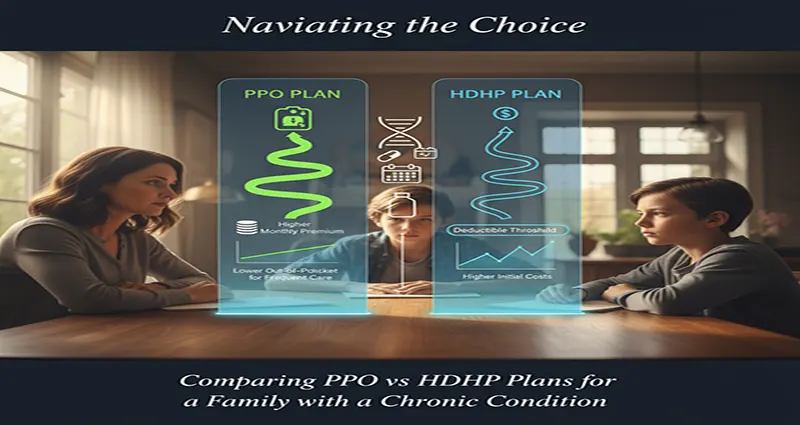For a family managing a chronic condition, the annual decision between a Preferred Provider Organization (PPO) and a High-Deductible Health Plan (HDHP) is far more than a simple cost comparison. It is a critical choice that directly impacts access to necessary care, financial stability, and peace of mind.
While HDHPs are often hailed for their low monthly premiums and tax-advantaged Health Savings Account (HSA), the financial realities of ongoing, high-frequency medical needs typically tip the scales in favor of a traditional PPO.
The Core Difference: Premium vs. Deductible
Understanding the fundamental trade-off is the starting point for any family with predictable, high healthcare usage.
| Feature | Preferred Provider Organization (PPO) | High-Deductible Health Plan (HDHP) |
| Monthly Premium | Higher | Lower |
| Annual Deductible | Lower | Higher (Meets an IRS minimum) |
| Access to HSA | Typically No | Yes (HSA-Eligible) |
| Cost of Service | Copayments or Coinsurance start sooner (often before deductible is met) | Full cost paid by the patient until the high deductible is met |
For a family with a chronic condition—such as diabetes, multiple sclerosis, or complex heart disease—medical expenses are not if, but when. This predictable, high usage is the main reason a PPO often makes the most financial sense.
1. The Financial Burden of the Deductible
A chronic condition requires frequent specialist visits, regular lab work, and expensive maintenance medications.
- PPO Advantage: With a significantly lower deductible, the family reaches the point where their insurance begins to share costs much faster. Once the deductible is met, copayments for ongoing care are relatively low and predictable, allowing for easier monthly budgeting.
- HDHP Hurdle: The family must pay 100% of all services, including prescriptions and recurring specialist visits, until they hit a very high family deductible (which can be over to and sometimes much higher). This high upfront cost must be paid every year, creating a substantial financial strain at the beginning of the plan year, often referred to as the “deductible gap.”
2. The Total Cost Calculation: Maxing Out
For a family with a chronic condition, it is highly likely they will hit their annual Out-of-Pocket Maximum (OOPM). When comparing plans, the focus shifts from the deductible to the total worst-case scenario.
In many cases, even when an HDHP has a higher OOPM than a PPO, the savings from the lower HDHP premium do not fully offset the difference.
Example Scenario (Hypothetical):
- HDHP: Annual Premium: + Family OOPM: = Total Max Cost:
- PPO: Annual Premium: + Family OOPM: = Total Max Cost:
In this common scenario, the PPO saves the family in total worst-case expenses, despite having a much higher monthly premium.
3. Predictability and Cash Flow
For a family budget, predictability is as valuable as savings.
- PPO: Allows the family to budget for a higher, predictable monthly premium, and then relatively small copayments for each service throughout the year. The bulk of the expense is spread out.
- HDHP: Requires the family to be able to immediately access and pay thousands of dollars upfront for the deductible—a significant strain on monthly cash flow that could lead to delaying necessary care. Studies have shown that the high cost-sharing of HDHPs can cause patients to delay or forgo critical care, an unacceptable risk for those with chronic diseases.
4. Specialist Access and Network Flexibility
The ability to access the best specialists quickly and easily is essential for chronic disease management.
- PPO: Generally offers the greatest flexibility and broadest networks. Patients can typically see specialists without a referral and have some coverage for out-of-network providers, which is crucial if a specific, world-renowned specialist is not in-network.
- HDHP: While many HDHPs use a broad PPO network, the cost for out-of-network care is almost always higher and may not count towards the in-network OOPM, risking unpredictable, devastating bills.
The HSA Factor: A Valuable Consideration, But Not the Deciding Factor
The one significant advantage of an HDHP is the Health Savings Account (HSA).
An HSA allows the family to contribute pre-tax money for healthcare expenses, which grows tax-free and can be withdrawn tax-free for qualified medical costs. This triple-tax advantage is a powerful long-term wealth-building tool.
However, for a family with high chronic care costs, the HSA funds will likely be spent immediately to cover the high deductible. While valuable, this long-term savings opportunity usually does not outweigh the immediate, predictable, and lower total financial risk of the PPO plan.
Conclusion: Prioritizing Predictability and Access
For a family managing a chronic condition, the Preferred Provider Organization (PPO) plan is typically the safer and more cost-effective choice. It prioritizes a predictable financial structure, minimizes large upfront out-of-pocket payments, and ensures easier access to the necessary specialists and ongoing care required for maintaining health.
The low monthly premium of an HDHP is an attractive lure, but for a high-utilization family, it translates directly into a painful transfer of risk, forcing them to shoulder thousands of dollars in medical costs at the most financially vulnerable point in the year. The PPO’s higher premium acts as a buffer, ensuring the insurance company starts covering essential care much sooner.











